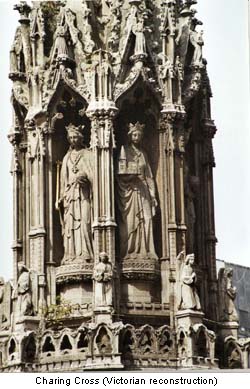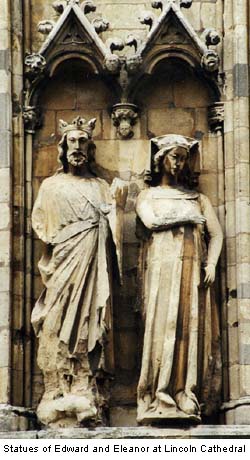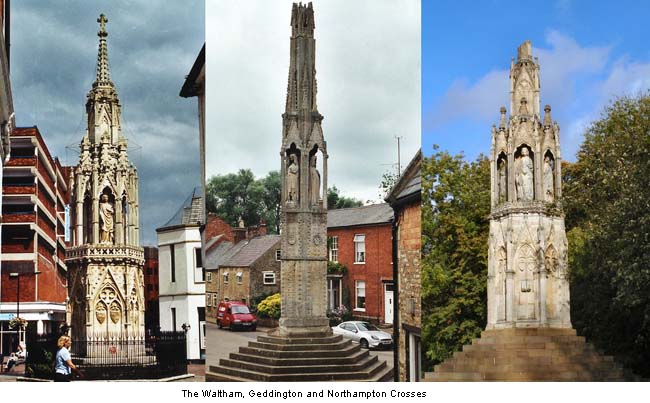The Eleanor Crosses: A Love Story in Stone
by Sara Eliot
 Most British readers will know of the existence of Charing Cross
station in London. Some are familiar with the replica Cross
itself, which now dominates the station forecourt. It is reckoned
to be the centre of the capital from which all distances are
measured. Fewer people know about King Edward I and Queen Eleanor
of Castile. Theirs was a story of an arranged marriage which
became true love. Most British readers will know of the existence of Charing Cross
station in London. Some are familiar with the replica Cross
itself, which now dominates the station forecourt. It is reckoned
to be the centre of the capital from which all distances are
measured. Fewer people know about King Edward I and Queen Eleanor
of Castile. Theirs was a story of an arranged marriage which
became true love.
It is often thought that Charing -- the place -- is named after
Eleanor. "Chere Reine" can translate as Beloved Queen
and the cross at Charing was the last to be built at Edward's
command after Eleanor's final sad, journey in 1290. But this is
an appealing fallacy: the true derivation comes from an earlier,
Saxon word Cyring, meaning 'at the bend of the river'.
Eleanor, born in 1244, was a Spanish princess -- the Infanta of
Castile. Her father was Ferdinand III, King of Castile and Leon,
her mother Joanna, Countess of Ponthieu. King Henry III of
England negotiated a marriage between the princess and his son
Edward, who was to become the next King of England.
Henry III was having problems at home with warring barons as well
as a threatened conflict with Alphonso, King of Castile and Leon
in Spain. The arrangement was that Eleanor's half-brother
Alphonso would, on Eleanor's marriage, transfer any claims on
Gascony to Lord Edward. In August 1254 the marriage took place
near Burgos in Castile. The wedding was lavish and attended by
royalty from many countries. (Henry III was criticised at home
for overspending.) Edward was in his teens and Eleanor several
years younger.
Edward, who became king on his father's death in 1272, was a
great lawmaker, but could be an impatient and sometimes petulant
king. Eleanor's gentleness seems to have influenced his behaviour
for the better. Once they started married life, Edward and his
Queen became inseparable. Where Edward went -- and he travelled
widely -- so did she. The first child of the marriage was born
when Eleanor was twenty -- a daughter, Eleanor Plantagenet. She
was to be the eldest of sixteen children. Sadly, as was all too
common in those days, only six survived to adulthood and only two
or three outlived their parents. Many of the couple's children
who died young are buried inWestminster Abbey: infant girls Joan
and Berengaria (or Berenguela), boys, John and Henry and little
Alphonso, Earl of Chester, who died when he was eleven. One
daughter, Mary, became a nun in Wiltshire; other children died in
infancy. In 1284 another boy was born who lived to become King
Edward II of England.
In 1272 Edward I led his army to the Holy Land in the Ninth
Crusade, accompanied by his Queen. One newborn child died there;
another -- Joan of Acre -- survived. At Haifa Edward was stabbed
with a poisoned dagger. Legend has it that Eleanor herself saved
his life by sucking the poison from the wound.
Some sources suggest that in the autumn of 1290 Edward was
travelling to Scotland and that he and the Queen were separated.
It is more likely that they were both at the Palace of Clipstone
in Sherwood Forest where parliament had been summoned and that
they wanted to make a pilgrimage to the tomb of Hugh of Lincoln.
Eleanor had been ill at Clipstone and may have had weakened
lungs; she did not complete the journey to Lincoln, but, attended
by Bishop Oliver Sutton of Lincoln, died a few miles away at
Harby on 28 November 1290.
 Edward was desperately saddened and shut himself away to mourn.
He wrote: "Living I loved her dearly and I shall never cease
to love her in death." Eleanor had planned for her death;
she wished her heart to be taken to the Black Friars in London.
Her body was taken to St Catherine's Priory, Lincoln where it was
embalmed. Her other organs were buried in Lincoln Cathedral.
However, as Edward's queen, her final resting place was to be
Westminster Abbey.
Edward was desperately saddened and shut himself away to mourn.
He wrote: "Living I loved her dearly and I shall never cease
to love her in death." Eleanor had planned for her death;
she wished her heart to be taken to the Black Friars in London.
Her body was taken to St Catherine's Priory, Lincoln where it was
embalmed. Her other organs were buried in Lincoln Cathedral.
However, as Edward's queen, her final resting place was to be
Westminster Abbey.
The cortege set off on the long journey to London. Soon after
Eleanor's death, Edward ordered for crosses bearing statues of
the Queen -- the Eleanor Crosses -- to be erected at places where
the procession stopped overnight. Their purpose was to remind
passers-by to say a prayer for the soul of the "Queen of
Good Memory", as Eleanor was called. The King commissioned
his Master Mason to provide a basic design for the 12 crosses.
Each was to have a plinth of steps and be built in three stages:
the lowest adorned with the carved shields of Eleanor's heraldry
-- the arms of England, Ponthieu and Castile & Leon. The
second level was a platform to carry statues of the Queen; the
highest would continue the column and be surmounted by a
cross.
The first cross was built near St Catherine's Priory, Lincoln. It
was destroyed during the Civil War but a fragment was saved. You
can see it in the grounds of Lincoln Castle.
The procession stopped at Grantham, where a cross was built on
what is now St Peter's Hill on the High Street. Cromwell's forces
later destroyed it. The cross at Stamford met the same fate; its
site is thought to be in Scotgate. The cortege left the Great
North Road and stopped to rest at Geddington, near Northampton
where the Queen's body was received into the church of St Mary
Magdalene. The Geddington Cross, built in 1294, survived the
Civil War, although it was damaged in the 18th century and has
been repaired. Set in the heart of the village, it is probably
the best preserved of the remaining crosses. It is triangular and
richly decorated, with three recessed statues of Eleanor.
On 9th December the funeral procession reached Northampton. The
Queen's embalmed body lay for the night at Delapre Abbey at
Hardingstone, just south of the town. The Hardingstone Cross was
built south of the Abbey entrance (where the County Records
Office now stands) on a slight hill where it can be seen by
passing travellers. This cross is less well preserved than that
at Geddington and has undergone much renovation over the years;
it has lost its third level and cross. But it is still a striking
landmark.
The cortege next stopped at Woburn and little is known of the
cross erected there. The following night's resting place was
Stony Stratford. The cross stood at what is now High Street and
was another casualty of the Civil War, remembered only by a
plaque. The procession left Watling Street and moved on 11 miles
to Woburn where the next cross was built. Very little -- not even
the location -- is known about the Woburn Cross.
Another nine miles brought the cortege to Dunstable. The site for
the Eleanor Cross -- near the entrance to Church Street -- was
carefully chosen and the ground sprinkled with holy water. There
is nothing to be seen of it now, but the Queen is remembered by
the Eleanor Precinct named after her.
The next night's rest was at the abbey at St Albans. The funeral
procession was met at the town's northern boundary by the Abbot
and his monks, who escorted the body to the abbey and laid it
before the high altar. Later, Cromwell's troops destroyed the top
of the St Albans cross and townspeople demolished the rest in the
early 18th century.

Another abbey, at Waltham, was the tenth resting place. The
town's name -- Waltham Cross -- is derived not from the Queen's
cross but from an earlier legend. Waltham's hexagonal Eleanor
Cross survived the Civil War and now stands in a pedestrian
precinct. The King, with his courtiers and some of the clergy,
had ridden ahead so that he could receive the body of his dead
wife. The procession did not go directly to Charing but to
various monasteries in the city of London. Eleanor's body was
carried to St Paul's Cathedral for the night and Masses were said
for her. Her heart was taken to the Black Friars, as she had
wished.
Cheapside (opposite what is now Wood Street) was the chosen site
for the penultimate Eleanor Cross. It was more costly than the
others and, although it was a great London landmark, it fell into
ruin. There were thought to be religious statues on the Cheapside
cross; and for this reason it was attacked by anti-Catholics in
the late 16th century. The Puritans finally completed its
destruction.
Perhaps the funeral procession rested for a while at Charing
before entering Westminster Abbey. The cross by the station is a
later version of the most elaborate and expensive of them all,
which was originally sited where Whitehall meets Trafalgar
Square. The replica was finished in 1863 and has eight statues of
Eleanor with kneeling angels at her feet.
The last journey of Eleanor "The Faithful" ended at
Westminster Abbey. The "Queen of Good Memory" had come
to her final resting place.
More Information:
We regret that we no longer have the resources to maintain up-to-date links and/or hours and pricing details for the various sites and attractions listed on this website. For more information about the location(s) listed above, please use your favorite search engine or visit Wikipedia.
Article © 2008 by Sara Eliot
Charing Cross and Statues photos by Simon Cave; Geddington Cross
photo courtesy of Northampton Tourist Office; Waltham Cross photo by Sara Eliot; Northampton Cross photo courtesy of Wikipedia.org
| 